This site is supported by our readers. We may earn a commission, at no cost to you, if you purchase through links.
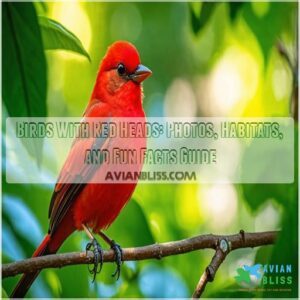
These avian wonders sport bright head plumage, displaying colors that span the vibrant spectrum—enough to make a rainbow jealous.
They lead fascinating lives, from the Crimson Sunbird’s nectar-sipping antics to the Western Tanager’s berry feasts.
Adaptations like specialized bills showcase their diverse eating habits.
These birds often navigate lengthy migrations, proving they’re not just pretty faces.
Want to attract these red-headed beauties to your yard? A few tips could turn your backyard into a feathered paradise.
Table Of Contents
- Key Takeaways
- Types of Red-Headed Birds
- Acorn Woodpecker
- Anna’s Hummingbird
- Brazilian Tanager
- Cassin’s Finch
- Crimson Sunbird
- Northern Cardinal
- House Finch
- Downy Woodpecker
- Red-bellied Woodpecker
- Barn Swallow
- Red-headed Woodpecker
- White-winged Crossbill
- Cinnamon Teal
- Summer Tanager
- Scarlet Tanager
- Western Tanager
- Pileated Woodpecker
- Ladder-backed Woodpecker
- Vermilion Flycatcher
- Red-breasted Sapsucker
- Red-faced Warbler
- Ring-necked Pheasant
- Physical Characteristics of Red-Headed Birds
- Red-Headed Bird Diets and Habitats
- Identifying Red-Headed Birds
- Attracting Red-Headed Birds to Your Backyard
- Red-Headed Bird Behavior and Adaptations
- Conservation Status of Red-Headed Birds
- Interesting Facts About Red-Headed Birds
- Red-Headed Bird Migration Patterns
- Red-Headed Bird Watching
- Frequently Asked Questions (FAQs)
- What types of birds have red heads?
- Why do some birds have red heads?
- Are red headed birds found in all regions of the world?
- Are red headed birds only found in adult birds?
- Are red headed birds protected species?
- Can red headed birds be kept as pets?
- What kind of birds have red on their head?
- What bird has a red head but not a cardinal?
- What looks like a sparrow but has a red head?
- What is a GREY bird with a red head?
- How do red-headed birds communicate?
- Why do birds have red plumage?
- Are certain red-headed birds endangered?
- What are the threats facing red-headed birds?
- How do red-headed birds choose their mates?
- Conclusion
Key Takeaways
- You’ll find many birds with striking red heads like the Northern Cardinal and Acorn Woodpecker, each bringing vibrant color and unique behaviors to various habitats.
- Attracting these birds to your backyard involves providing diverse food sources such as seed and suet feeders, berry bushes, and nesting boxes.
- Red-headed birds face threats like habitat loss and climate change, making conservation efforts vital for their survival and well-being.
- The Northern Cardinal’s bright red plumage, for instance, is a prime example of the bold colors exhibited by small red birds. These birds use their red plumage for communication and mate attraction, with intricate social behaviors and impressive migration patterns adding to their fascinating lives.
Types of Red-Headed Birds
You’re about to explore a world filled with birds sporting fiery crowns and brilliant scarlets, like the vibrant Acorn Woodpecker and the striking Brazilian Tanager.
Whether you’re a seasoned birder or just peering out your window, these red-headed wonders promise to brighten your view and maybe even spark a little bird-themed envy among the other backyard inhabitants.
Acorn Woodpecker
Picture the Acorn Woodpecker, a funny bird that’s all about teamwork.
It builds impressive "granaries" filled with acorn treasures.
You’ll spot its bold red cap among the trees, where these social birds craft homes and store acorns.
Clever adaptations help it thrive by tapping into rich insect diets, making it a standout in any list of red-headed birds.
Anna’s Hummingbird
Anna’s Hummingbird captivates with its small reddish-pink cap.
You’ll spot these agile creatures across North America, hovering with precision to sip nectar.
Consider these tips:
- Hummingbird feeders are essential.
- Nectar sources attract them.
- Hummingbird migration patterns are fascinating.
- They exhibit fascinating hummingbird behavior.
- Included in any bird identification guide.
Their vibrant colors make them a highlight among common birds.
Brazilian Tanager
Sure, Anna’s Hummingbird charmed you with its shimmer, but wait until you meet the Brazilian Tanager!
This vibrant bird, with a bright red head and body, thrives in Brazil’s shrublands and wetlands.
Its diet variations include insects and fruits.
Despite habitat threats, conservation efforts are underway.
Next time you’re birdwatching, spot this gem for an unforgettable experience!
Cassin’s Finch
Imagine you’re exploring the mountains, and you spot a Cassin’s Finch, with its pinkish hues and cheerful song.
Found across the western U.S., it enjoys munching on seeds and berries, sometimes near salt deposits.
Notoriously social, these finches often flock with Grosbeaks.
Birdwatching would reveal their charming nesting habits and vibrant feather color—truths that warm any birder’s heart.
Crimson Sunbird
Next up is the dazzling Crimson Sunbird! This tiny jewel boasts a vibrant red head and a striking black mask.
You’ll find these nectar-feeding acrobats across Asia, showcasing amazing hovering flight.
Their breeding season varies by location; a great addition to any bird identification guide.
Keep an eye out for these beauties during your birdwatching adventures – their "chewee-cheewee" call is quite distinctive!
Birdwatching locations across their Asian Distribution offer incredible bird sightings.
Northern Cardinal
Shifting from the vibrant Crimson Sunbird, let’s talk Northern Cardinals.
These birds are known for their distinct physical characteristics, with male cardinals having vibrant red plumage that sets them apart, learn more about red robin vs cardinal. These iconic birds charm with their bright red feathers and powerful Northern Cardinal calls.
Here’s what makes them special:
- Cardinal Diet: Seeds, fruits, and insects.
- Cardinal Mating Rituals: Surprisingly elaborate!
- Cardinal Nest Building: Intricate artists.
- Northern Cardinal Range: Found throughout eastern and southern states.
House Finch
While the Northern Cardinal is all about bold red, let’s shift our gaze to the House Finch.
With males flaunting red heads and breasts, and females sporting brown streaks, these charming birds are common at feeders.
Their habitat spans parks to farms, and they adapt well in urban areas.
Bird watchers cherish their lively antics and melodic songs.
Downy Woodpecker
Ever spotted the charming Downy Woodpecker in your backyard?
This tiny bird, only 6-7 inches long, is a regular visitor to feeders.
You’ll hear its lively calls as it searches for insects in trees.
Here’s your Downy Woodpecker checklist:
- Habitat: Woodlands, parks, and backyards
- Diet: Insects, seeds, and sap
- Conservation: Stable, adaptable species
Birdwatchers delight in its antics!
Red-bellied Woodpecker
A Red-bellied Woodpecker might draw your attention with its black and white striped back and pale red belly.
Don’t be fooled by its name—its head boasts bright red feathers too.
It thrives in woodlands, delighting birdwatchers with its rhythmic drumming and unique calls.
These woodpeckers play a key role in their ecosystem as seed dispersers, ensuring a vibrant forest habitat.
Barn Swallow
Imagine barn swallows gracing your summer skies.
These acrobatic avians delight with their swift swallow flight.
You’ll spot them building barn swallow nests from mud like artists at work.
Their insect diet helps keep pesky bugs away.
When swallow migration arrives, your heart might yearn for birdwatching destinations where these beauties continue their elegant dance.
- Mud nest artists
- Insect diet enthusiasts
- Migratory travelers
- Sky acrobats
Red-headed Woodpecker
Start your adventure with the Red-headed Woodpecker.
This bird sports a crimson head and loves open spaces dotted with trees.
Listen for its drumming and sharp calls.
Known for storing acorns in woodpecker granaries, it’s sadly declining and needs our help through conservation efforts.
Keep an eye out for these vibrant chatterboxes!
| Feature | Description | Fun Fact |
|---|---|---|
| Color | Bright red head | Also black and white body |
| Habitat | Open areas, deciduous trees | Found in eastern United States |
| Conservation Status | Declining | Needs preservation efforts |
White-winged Crossbill
So, you’ve learned about the Red-headed Woodpecker.
Now, let’s meet its quirky cousin, the White-winged Crossbill!
Notice its amazing, crossed bill—a perfect tool for its Cone-Eating Technique.
This Crossbill Adaptation helps it extract seeds from conifer cones.
Their Conifer Dependence is strong, shaping their lives.
Males sport a striking red head during Breeding Season, while females are a more subdued yellow-brown.
Isn’t nature incredible?
Cinnamon Teal
Meeting a Cinnamon Teal in the wetlands is like spotting a hidden gem.
Its rich, rusty red male plumage shines brightly during the breeding season.
They prefer marshy habitats, nesting among reeds with their families.
Currently, their conservation status is stable, but awareness is key!
These ducks are part of nature’s picturesque palette.
- Unique male plumage
- Prefers wetlands
- Breeds in spring
- Stable conservation status
- Marshland resident
Summer Tanager
From the rich rust of the Cinnamon Teal, let’s explore the vibrant Summer Tanager.
These birds flaunt a brilliant red, especially the males, while females sport a mustard yellow.
Living in wooded areas, they’re adept at nest building.
Their cheerful song faces threats from habitat loss, but conservation efforts bloom like wildflowers in spring!
| Trait | Males | Females |
|---|---|---|
| Color | Bright Red | Dark Mustard Yellow |
| Habitat | Wooded Areas | Wooded Areas |
| Conservation Status | Concern due to Habitat Loss | Concern due to Habitat Loss |
Scarlet Tanager
After the Summer Tanager’s visit, you’ll spot the breathtaking Scarlet Tanager in leafy woodlands.
The male dazzles with his scarlet body, contrasting black wings during breeding season, while the female sports a subtler yellow.
Listen for their unique, cheerful song echoing through the forest.
They prefer habitats rich in trees, reminiscent of a colorful artist’s palette brought to life.
Western Tanager
Picture a Western Tanager‘s vibrant beauty—its fiery orange-red face is like nature’s masterpiece.
During the breeding season, these birds can be found across the Western Tanager Range, munching on insects and berries.
Watch out for their melodies, which echo through forests.
Though not endangered, slight conservation concerns exist, mainly due to habitat loss affecting their nesting habits, which is also a significant factor in the decline of their long-term monogamous relationships as explained in Cardinal Social Behavior.
Pileated Woodpecker
The Pileated Woodpecker, with its brilliant red crest, steals the spotlight as one of America’s largest woodpeckers.
You’ll find these drumming maestros in North American woodlands, hammering away at trees in search of insects.
Their unique rectangular nesting cavities provide both shelter and humor, as they sometimes knock so passionately, you’d think they’re auditioning for a bird percussion band!
Ladder-backed Woodpecker
From giant woodpeckers, meet the Ladder-backed Woodpecker! It’s a small, red-crowned marvel darting through woodlands. You’ll love its quirks:
- Nesting Habits: Digs cavities in cacti or trees.
- Habitat Preferences: Loves arid scrublands.
- Diet Specifics: Relishes insects and sap.
- Unique Calls: Chatters and drummings enchant the ears.
Their conservation status remains stable, so keep an eye out!
Vermilion Flycatcher
Someone once told me, Vermilion Flycatchers are stunning! Their bright red heads and bellies are a real showstopper.
You’ll find these birds across a wide Vermilion Flycatcher range, from Mexico to South America.
Their nesting habits are fascinating; they build their nests in cavities.
Identifying their song can be tricky, but it’s a rewarding challenge.
Luckily, their conservation status is secure, for now.
They’re known for their mimicry behavior, adding to their charm.
| Feature | Description |
|---|---|
| Range | Mexico to South America |
| Nesting Habits | Cavity nesters |
| Song Identification | Unique, but can be challenging to learn |
| Conservation Status | Currently secure |
| Mimicry Behavior | Yes |
Red-breasted Sapsucker
Imagine spotting the vermilion flycatcher—now, let’s meet its cousin, the red-breasted sapsucker.
This charming bird flaunts red plumage flowing from its head to breast.
You’ll find it nesting in woodlands across its range.
Its diet includes sap, insects, and fruits.
Sapsucker calls are distinct, much like its vibrant looks.
Conservation efforts are simply a must to protect such beauty.
Red-faced Warbler
While the Red-faced Warbler mightn’t serenade you with a hit song, it sure knows how to captivate.
Spot these lively birds flitting about in woodland habitats where they feast on insects.
To pique your curiosity, here’s a bird’s-eye view:
- Habitat: Woodlands
- Diet: Insects galore!
- Song: Cheerful and melodic
- Nesting: Fascinatingly intricate
Ring-necked Pheasant
Just as the Red-faced Warbler captures attention with its striking red head, the Ring-necked Pheasant impresses in different ways.
This introduced species has adapted remarkably well to North America, bringing with it not just vibrant male plumage but opportunities for conservation and pheasant hunting.
Consider habitat management to support these charming birds as they enrich our fields and grasslands.
Physical Characteristics of Red-Headed Birds
Picking up from the fascinating types of red-headed birds, let’s explore their physical characteristics.
These birds captivate with their vivid plumage and variety in shape and size.
You’re not imagining things when you notice the red head size or color variation; these features are nature’s art.
Consider the bill shape—an acorn woodpecker’s powerful drill differs from the graceful nib of a hummingbird.
Notice their wingspan, which can be surprisingly wide, fueling incredible flight patterns.
- Plumage Patterns: Some birds boast intricate designs, like the crimson sunbird with its colorful blend.
- Color Variation: From the bright crimson of Brazilian Tanagers to the subtle shades of Cassin’s Finch, reds come in many hues.
- Bill Shape: Each bill is adapted to the bird’s feeding habits and habitat needs.
Red-Headed Bird Diets and Habitats
As you explore the diverse diets and habitats of red-headed birds, you’ll find a fascinating array of dining preferences, from seed munchers to nectar sippers.
Picture these vibrant creatures, each with their unique feeding habits, thriving in environments as varied as dense forests, open fields, and bustling backyards.
Seed-Eating Birds
Many seed-eating birds sport red heads, adding a dash of color to your backyard.
Their seed preferences vary, but they all indulge in nature’s buffet.
Some even practice seed hoarding, creating secret stashes.
They play a role in seed dispersal, helping plants spread.
Check out their feeder behavior; it’s like watching a nature documentary right from your window!
| Bird Type | Seed Preferences | Habitat |
|---|---|---|
| Northern Cardinal | Sunflower seeds | Woodlands |
| House Finch | Thistle seeds | Urban parks |
| Cassin’s Finch | Conifer seeds | Mountainous areas |
| Red-bellied Woodpecker | Acorns | Woodlands |
| White-winged Crossbill | Pine seeds | Conifer forests |
Fruit-Eating Birds
So, you’ve learned about seed-eating birds.
Now, let’s explore fruit-eating birds!
Many species, such as the Northern Cardinal‘s vibrant plumage, have adapted to thrive in diverse habitats on fruit diets.
Their diets often include berries and other fruits.
Common fruit-eaters live in diverse habitats, from forests to gardens.
Identifying them involves noting their fruit-eating bird adaptations, like strong beaks.
Understanding fruit-eating bird diets and habitats helps you identify birds like the Steller’s Jay, which caches food like nuts and seeds to store for winter, often from the comfort of their western US coniferous forests. Understanding fruit-eating bird diets and habitats helps you attract these colorful birds to your backyard.
It’s a win-win!
Insect-Eating Birds
When you’re exploring the insect-eating habits of red-headed birds, you’ll notice interesting adaptations that align with nature’s rhythm.
For instance, birds like the Barn Swallow dart and swoop in intricate flight patterns, capturing their insect prey mid-air.
Such incredible agility reflects dynamic predator-prey dynamics.
With abundant insects, these birds thrive, using insect mimicry as a stealthy survival strategy, blending into their vibrant habitats effortlessly.
Nectar-Drinking Birds
Ever watched a hummingbird darting around, sipping nectar?
These tiny, red-headed wonders, like the Crimson Sunbird, use their long bills for reaching deep into flowers.
You can even attract them with a red head bird feeder, which will provide them with a steady source of nectar.
Create a welcoming space with hummingbird feeders overflowing with nectar sources.
Their migration patterns take them across continents, adapting brilliantly along the way.
It’s like fueling a tiny, flying sports car!
Identifying Red-Headed Birds
When you’re trying to spot a red-headed bird, start by noting its distinct color patterns and habitats.
Keep an eye out for unique behaviors, like a woodpecker’s rhythmic drumming or a hummingbird’s acrobatic flight, and soon you’ll be an expert at identification!
Using Visual Descriptions
As you explore red-headed birds, you’ll find that visual clues make identification fun.
Bird color variations are your friends here. Spot an Acorn Woodpecker’s black mask or a Crimson Sunbird’s vibrant red head. House finches, like those in Colorado, display their rosy red heads at red birds in colorado. Spot an Acorn Woodpecker’s black mask or a Crimson Sunbird’s vibrant red head.
Identifying by shape or comparing head sizes often helps. Notice feather patterns or wingspan differences; they’re like nature’s little cheat sheets for birdwatching enthusiasts.
Location and Habitat
Imagine spotting a vibrant red-headed bird in your backyard.
Consider these habitats to find them:
- Climate zones: Seek birds in diverse climates, from cool forests to sunny grasslands.
- Bird sanctuaries: Visit protected areas where red-headed beauties thrive.
- Urban landscapes: Surprisingly, cities offer homes to adaptable species.
Observe these hotspots, and you’re bound to enjoy some feathered encounters!
Behavioral Patterns
Spotting red-headed birds involves understanding their behavioral patterns.
Flocking behavior can often lead you to these vibrant creatures.
You might observe their unique courtship displays or note how they defend their territory.
Pay attention to foraging strategies and roosting habits.
Such behaviors can be clues that help you correctly identify these fascinating, feathered friends in their natural habitats.
Attracting Red-Headed Birds to Your Backyard
Want to transform your backyard into a vibrant red-headed bird haven?
You can attract these feathered friends by providing a variety of food sources like seed feeders, suet, and berry bushes.
Along with food sources, providing nesting boxes and fresh water is also essential.
Seed Feeders
Want to invite charming red-headed birds to your backyard? Start by offering a variety of seed types like sunflower and nyjer in easy-to-reach feeders.
Consider supplementing their diet with fun Red head bird toys.
Regular feeder maintenance is key to keeping your feathery guests happy.
Stand your feeders near bird-friendly plants for shelter and use strategic backyard placement.
Consider winter feeding, as birds appreciate a consistent food supply during colder months.
Suet Feeders
Turning your backyard into a red-headed bird haven is easy with suet feeders.
A lightweight suet packed with energy can attract woodpeckers and other birds.
Place feeders near trees for more visits.
Don’t fret about mess—just maintain them regularly.
Homemade suet is a great option, and comparing suet vs seed might surprise you with its benefits!
Platform Feeders
With platform feeders, you can easily attract red-headed birds to your backyard.
To increase your chances of attracting these birds, consider that Red-Headed Woodpeckers and Red-Headed Finches often forage for insects in trees, so using insect-friendly feeds can be beneficial.
Here’s how:
- Feeder Placement Tips: Position your feeder in a quiet spot with a clear view to avoid hawks swooping in.
- Bird Feeding Strategies: Mix seeds and mealworms for a protein-packed buffet.
- DIY Feeder Plans: Use sturdy materials like wood to weather the elements.
Berry Bushes and Fruit Trees
Planting berry bushes and fruit trees entices red-headed birds like cardinals into your yard. These avian visitors bring vibrant color while helping in garden bird pollination.
Here’s a quick guide:
| Task | Benefit |
|---|---|
| Berry Bush Care | Supports bird nutrition |
| Fruit Tree Pruning | Enhances growth and yield |
| Orchard Biodiversity | Attracts diverse species |
Don’t overlook the wonders of wild fruit foraging!
Nesting Boxes and Water Sources
Is your backyard ready to welcome red-headed birds? Try installing roosting boxes for shelter.
Set up DIY birdbaths for much-needed refreshment. Don’t overlook birdhouse maintenance to keep them inviting.
For those feeling adventurous, consider some pond construction. By combining these elements with bird-friendly plants, you’ll create an avian oasis that attracts our feathered friends effortlessly!
Red-Headed Bird Behavior and Adaptations
Now, let’s explore the fascinating world of red-headed bird behavior!
You’ll discover how their unique adaptations, from clever acorn storage to dazzling courtship displays, help them survive and thrive in diverse habitats.
Social Behavior
Imagine you’re a bird enthusiast intrigued by the social behavior of red-headed birds.
These feathered friends display fascinating traits:
- Flocking patterns help them avoid predators.
- Social hierarchies determine pecking order with humor at times.
- Foraging strategies serve as clever survival techniques.
- Communication signals guide interactions and strengthen bonds.
It’s like a chirpy soap opera in your backyard!
Mating and Breeding Habits
After getting a peek into their social quirks, you might wonder how red-headed birds keep the love alive.
Courtship rituals often sparkle like a dance show, with mate attraction in full swing.
Once set, these birds find breeding grounds to build homes. With impressive nesting strategies, many boast monogamous behavior, showing that lovebirds really do exist!
Unique Adaptations
A red-headed bird’s flair isn’t just in its plumage; it’s got tricks up its winged sleeves. Here’s the scoop:
- Feathered Camouflage helps them blend seamlessly into dense foliage.
- Beak Specialization aids in cracking tough seeds or sipping nectar.
- Tail Streamers boost maneuverability.
Who knew a splash of red could host such adaptations? It’s practically nature’s version of a Swiss Army knife!
Migration Patterns
While unique adaptations are key for survival, migration patterns also play a big role in red-headed birds’ lives.
You’d think bird tracking is like keeping tabs on feathered adventurers!
Some species follow intricate migratory routes, utilizing stopover sites and flyway corridors.
Altitudinal shifts mean elevation changes throughout the year, ensuring these birds always find the perfect spot to call home.
Conservation Status of Red-Headed Birds
You might think red-headed birds have it easy with their striking looks, but their conservation status tells another story.
While some face threats like habitat loss and climate change, others are benefiting from efforts to preserve their homes—who knew feathers could be so complicated?
Endangered Species
So, you’ve learned about their quirky behaviors.
Now, let’s talk about which red-headed birds need our help. Some species are struggling!
Here’s what you should know:
- The Red-headed Woodpecker’s numbers are dwindling.
- Habitat destruction is a major problem.
- Climate shift impacts their food sources.
- Species preservation efforts are underway. We can all help protect these amazing birds!
Threats to Red-Headed Birds
You’re probably wondering why red-headed birds face so many threats.
Imagine this: climate change shifts their habitats like moving a beloved furniture set; suddenly, nothing fits.
Many of these birds, such as the Red-Headed Woodpecker, rely on specific ecosystems like pine savannas and open woodlands, making habitat loss and fragmentation particularly devastating.
Habitat loss and bird collisions, like those caused by window reflections, disrupt their daily life.
Pesticide poisoning further jeopardizes their survival, making these brilliant birds’ world a more dangerous place to navigate.
Conservation Efforts
Imagine spotting a red-headed bird and wondering about its future.
Conservation efforts play an important role in ensuring their survival. Bird sanctuaries and wildlife refuges offer safe havens, while habitat restoration and species reintroduction breathe new life into threatened populations.
Through ecological research, scientists understand environmental impacts, helping these vibrant birds thrive—giving you the chance to enjoy their beauty for years to come, thanks to conservation efforts.
Interesting Facts About Red-Headed Birds
You’re about to discover some intriguing tidbits about red-headed birds, from their striking features to quirky habits.
Imagine a woodpecker that can stash away enough acorns to go on a nutty treasure hunt or a vibrant tanager that outshines a box of crayons!
Unique Characteristics
Leaving behind the challenges they face, red-headed birds bring something extraordinary to the table.
You’ll find their red head markings not just eye-catching, but essential for species recognition.
Head color variation brightens their world, while beak shape adaptation enhances their feeding techniques.
Plumage patterns and bright color purposes often play roles in mating rituals, making them fascinating to observe, highlighting the importance of color variation in their behavior.
Adaptations and Abilities
Red-headed birds exhibit incredible adaptations.
Picture their wing structures, perfectly crafted for swift flight patterns or gentle glides.
Beak shapes vary, with some designed for cracking seeds, others for sipping nectar.
Think of camouflage techniques; like nature’s magicians, these birds blend into leafy environments.
- Wing structure: Swift flight or gentle glide
- Beak shapes: Diverse for diet needs
- Camouflage techniques: Master survival skills
Fun Facts and Trivia
Bird brainpower amazes us all.
These birds flaunt vibrant red feathers, often a result of their red plumage, and are superb at adapting to their environment, like the Northern Cardinal’s distinctive red crown courtship rituals.
Explore these fascinating tidbits and more in the table below.
| Fact | Bird | Remarkable Trait |
|---|---|---|
| Red-Head Terminators | Northern Cardinal | Avian speedsters |
| Communal Living | Acorn Woodpecker | Granary creators |
| Nectar Navigators | Crimson Sunbird | Hovering abilities |
| Tailor-Made Feathers | Brazilian Tanager | Rare plumage |
| Ancient Artists | Vermilion Flycatcher | Ancestral lineage |
Red-Headed Bird Migration Patterns
When you think of red-headed birds, you mightn’t imagine them flying long distances, but many do!
From seasonal migrations to altitudinal shifts, these vibrant travelers start fascinating journeys, like tiny frequent flyers who forgot to pack their bags.
Seasonal Migration
Picture a flock of red-headed beauties beginning their seasonal migration.
It’s like a family road trip, but with wings.
As they soar to warmer climates, these birds stop, rest, and refuel at migratory stopovers.
Climate change impacts their journeys, but bird banding helps scientists track their paths.
Keep an eye out for these seasonal flocking events!
Altitudinal Migration
As winter wanes, you’ll find some birds choosing altitudinal migration over the usual long treks, a behavior also exhibited by certain populations of red-tailed hawks.
This vertical migration pattern helps them avoid bad weather by moving up and down the mountains.
Imagine these feathered travelers adapting to altitude effects as they navigate bird elevation zones and high elevation habitats, making mountain pass migration a fascinating spectacle to witness.
Long-Distance Migration
Experiencing breathtaking altitudes isn’t the only challenge for our avian travelers. Long-distance migration showcases their remarkable navigation methods and courage.
Consider these astounding facts:
- Birds in Transit cover thousands of miles.
- They follow ancient migratory routes.
- Fueling stops are critical for energy.
- Stars or magnetic fields guide their impressive journeys.
Nature’s endurance champions, don’t you think?
Red-Headed Bird Watching
You’ve tracked red-headed birds flitting from one region to another.
Now, let’s focus on spotting them in the wild. Grab your binoculars and a comfy hat, because bird watching offers a splendid escape. Whether it’s the Acorn Woodpecker storing acorns or the Northern Cardinal’s radiant plumage lighting up your backyard, each sighting is a delight.
Try backyard bird counts to contribute to citizen science while enjoying your breakfast coffee. Position those nesting boxes just right for feathered tenants.
Don’t fret about red-headed bird myths; these birds are as real as can be. Use a camera for capturing their vivid colors and unique flocking behaviors. Bird photography tips can turn a fleeting moment into a lasting memory.
Frequently Asked Questions (FAQs)
What types of birds have red heads?
Many birds sport red heads!
Think Northern Cardinals, Red-headed Woodpeckers, and even some hummingbirds.
Their red hues serve different purposes, from attracting mates to camouflage.
It’s a colorful world out there!
Why do some birds have red heads?
Some birds sport vibrant red heads to attract mates, signal good health, or mark territory.
This flash of color acts like nature’s own billboard, advertising their fitness and desirability in the avian dating scene.
Are red headed birds found in all regions of the world?
Red-headed birds spread their vibrant charm across regions, but not all corners of the globe host them.
While you might spot these colorful characters in diverse environments, their presence varies with suitable habitat and climate conditions.
Are red headed birds only found in adult birds?
Red heads aren’t exclusive to adult birds; some young birds also sport red feathers, though it may vary by species.
Red feathers are not just for grown-up birds.
Northern Cardinals, known for their bright red plumage in North Carolina, display vibrant colors in males. For example, juvenile Northern Cardinals show a hint of red as they mature.
Are red headed birds protected species?
Like a delicate balance in nature, whether red-headed birds are protected depends on the species.
Some, such as the Red-cockaded Woodpecker, enjoy legal protection due to their declining numbers, ensuring their survival for future generations.
Can red headed birds be kept as pets?
You can’t keep most red-headed birds as pets since they’re often wild and protected species.
It’s very important to research legal and ethical aspects before considering any bird as a pet.
They thrive best in natural habitats.
What kind of birds have red on their head?
A fiery crown, a splash of crimson—many birds sport red heads!
From tiny hummingbirds to majestic woodpeckers, a vibrant red head often signals a unique species.
Check out field guides to identify them!
What bird has a red head but not a cardinal?
If you’re on the lookout for a bird with a striking red head, check out the Red-headed Woodpecker or the Vermilion Flycatcher.
These charming birds are as eye-catching as they’re intriguing.
What looks like a sparrow but has a red head?
A bird that resembles a sparrow but sports a red head is the House Finch.
Males display a vibrant red head and breast, while females are more subtle with brown streaks.
They’re common at feeders and parks.
What is a GREY bird with a red head?
In a world where colors paint tales, envision a Crimson Sunbird.
This vibrant creature boasts a deep red head contrasting its grayish-olive body.
Its unique color combination is truly a masterpiece of nature’s palette.
How do red-headed birds communicate?
Chirps, calls, and beak clicks make up the symphony of red-headed birds.
They communicate for finding mates and warning of danger, each note a unique signal.
It’s like nature’s own social network, all within vibrant feathers!
Why do birds have red plumage?
Birds sport red plumage mainly to dazzle and attract potential mates.
This vibrant color comes from carotenoid pigments, which they get from their diet.
Plus, it helps in signaling territorial dominance among other birds.
It’s like their flashy suit!
Are certain red-headed birds endangered?
The Red-headed Woodpecker faces declining numbers, partly due to habitat loss.
While not officially endangered, it’s a species to watch.
Keep your eyes peeled for these striking birds and support conservation efforts to protect their homes.
What are the threats facing red-headed birds?
Habitat loss, climate change, and predation threaten many red-headed birds. Some species face additional challenges like competition for resources or disease. Conservation efforts are essential for their survival.
How do red-headed birds choose their mates?
Imagine lovebirds choosing partners through vibrant dances and songs.
Red-headed birds often exhibit bright plumage and enchanting calls.
They seek healthy, strong mates, ensuring survival and genetic vigor, creating a vibrant mosaic of avian affection and energy.
Conclusion
Imagine your backyard as a haven for birds with red heads, a place where these dazzling creatures bring vibrant life and charm.
By understanding their habits and needs, you can welcome Northern Cardinals or Acorn Woodpeckers to your own mini paradise.
It’s not just about looks—it’s about sustaining their fascinating lifestyles and migrations.
As you watch these stunning birds thrive, you’ll realize that your efforts create much more than beauty; they build vital connections with nature.
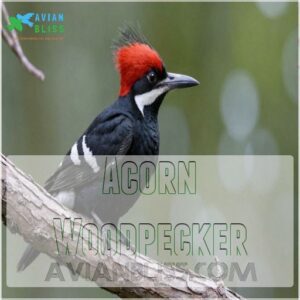
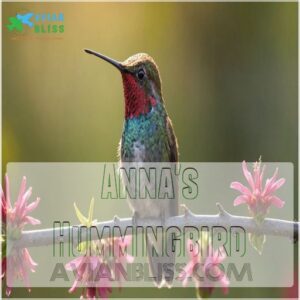

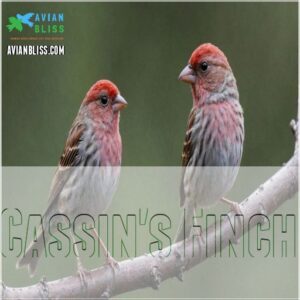
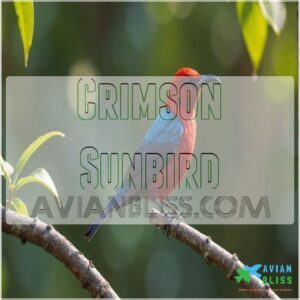


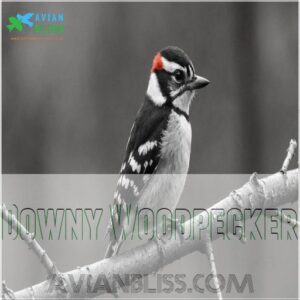
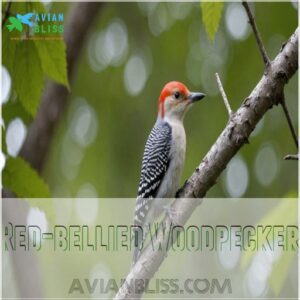
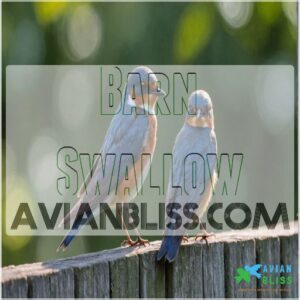
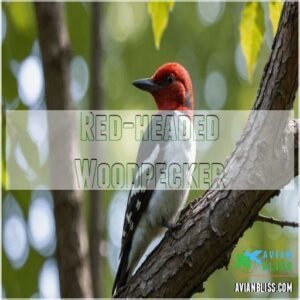


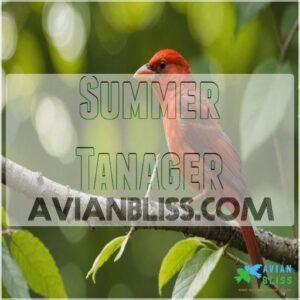

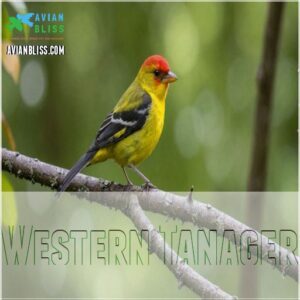
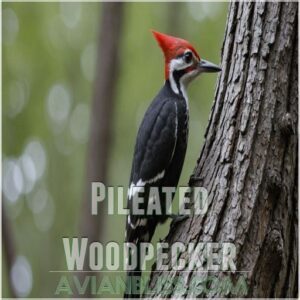
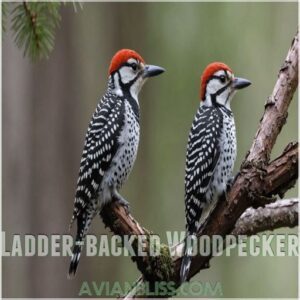
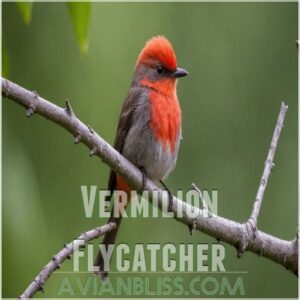
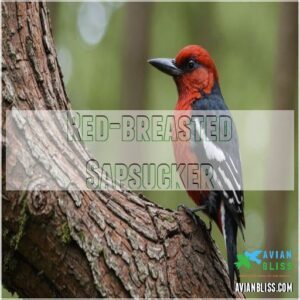


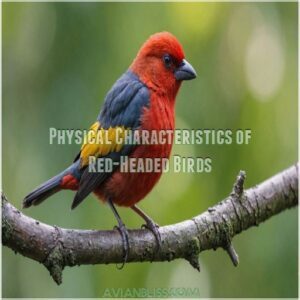

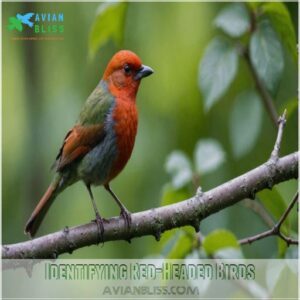

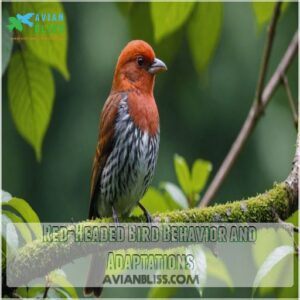
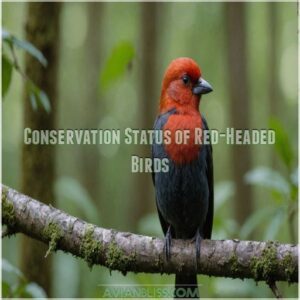


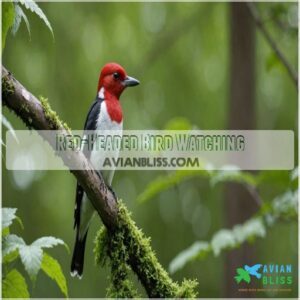
0 Comments